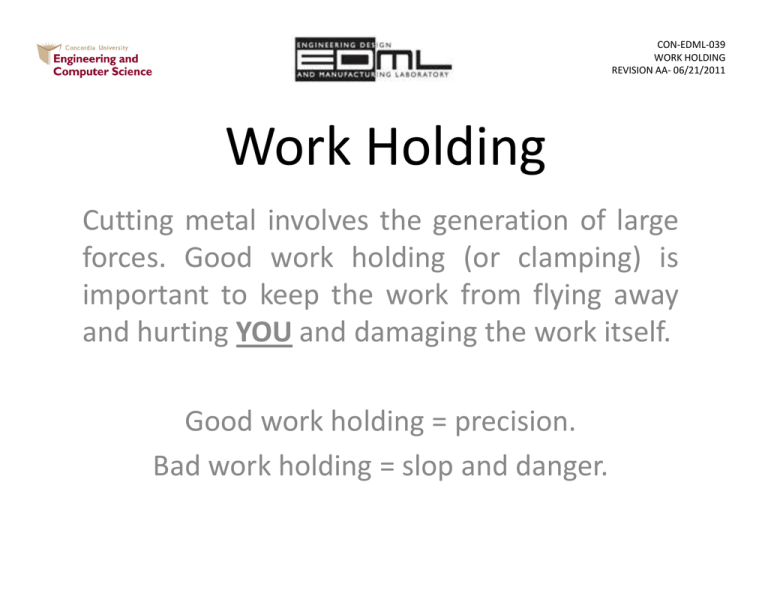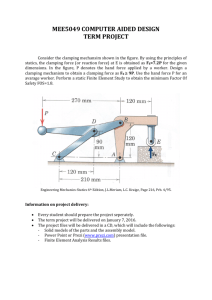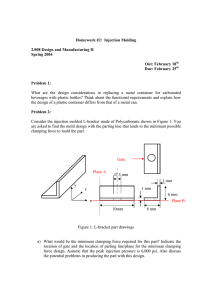CON-EDML-039 Work Holding
advertisement

CON-EDML-039 WORK HOLDING REVISION AA- 06/21/2011 Work Holding Cutting metal involves the generation of large forces. Good work holding (or clamping) is important to keep the work from flying away and hurting YOU and damaging the work itself. Good work holding = precision. Bad work holding = slop and danger. CON-EDML-039 WORK HOLDING REVISION AA- 06/21/2011 Work Holding • This document is a selection of Work Holding case studies. • There is no single RIGHT way to hold your work! • Cases are provided with commentary to provide insight into various work holding techniques. • Use these examples and comments as building blocks. CON-EDML-039 WORK HOLDING REVISION AA- 06/21/2011 A few good pointers to start (Applies to almost all work holding jobs) • Metal-on-metal-on-metal. • Clean Clamping. • Tip of the Clamp. • No Twist. • Where’s that tool going? To clamp is to put things in compression. If the clamping force is not directly supported, there will be bending moments created. This will cause distortion in parts in the best case, and can cause parts to fly away with spring energy if the clamp lets go. Clamping is compression. Debris, especially chips from previous operations, will cause damage when caught between the clamp and the workpiece. It will also let the work move, and may result in the work slipping out and flying away. Clamps need to clamp in compression. It is very important that ONLY the clamp tip touches the work. This ensures that the force is directed straight down through the work, keeping everything in direct compression. Cutting forces will generate forces in many directions. Engineers are expected to understand where these forces will be directed and design Work Holding setups and devices accordingly. Failure to do so will result in ruined work and/or injury as the improperly restrained forces cause the work to pivot about the clamp. Work Holding must not interfere with the movement of the cutter doing the cutting. Check the cutter path BEFORE starting to cut. • What’s under the tool? • Just enough force. • Support Structure. If work does not have a solid cross-section, then creative use of screw jacks, pieces of material, or other Cutters will cut the machines as easily as the work. If the cutting operation is through the work, be mindful of what the cutter will be cutting under the work. Consumable materials can be placed under the work to support it, especially in the case of thin and delicate work. Precision milling in sheet metal is an example of this. Over clamping can cause elastic distortions of the work which leads to loss of accuracy as well as damage to finished surfaces. Severe over clamping crushes work. Under clamping will let the work fly. Clamping in compression (metal-onmetal-on-metal) causes the minimum distortion. Consider using clamping intermediates like brass shim stock to save surface finish. objects may be used to achieve metal-on-metal-on-metal clamping. • Clamp Near Cutting. Clamps are most effective when placed as near as possible to the cutting action. CON-EDML-039 WORK HOLDING REVISION AA- 06/21/2011 Case 1a: Clamping to Table - Poor Metal-on-metal-on-metal. This setup does not have the clamping force directed onto the table surface directly. Just enough force. Looking carefully at the clamp, we can see that the steel clamp is actually bent. The soft aluminum underneath will suffer in this setup. Tip of the Clamp. A free body diagram of the clamping action would show that the clamping setup is inducing side forces on the work. This is not pure compression. CON-EDML-039 WORK HOLDING REVISION AA- 06/21/2011 Case 1b: Clamping to Table - Good No Twist. The addition of the third clamp distributes the forces, minimizing distortion. Two clamps on opposing sides of the work will also work to stop twisting of work. Metal-on-metal-on-metal. It can be seen that clamping force is transferred directly into the table. Direction of Force CON-EDML-039 WORK HOLDING REVISION AA- 06/21/2011 Case 2: Sheet Metal Tip of the Clamp. By not supporting the other side of the clamp, this setup is unsafe. Problems: 1) The piece is not being pushed straight down, and if given a chance, the far side will tend to pop up. 2) Touching just the edge of the work does not allow the clamp a firm hold on the work. The work could easily slip and move in this setup. What’s under the tool? A disposable wooden backing board has been used under the work, so that the tool can cut into it instead of the machine table (which ruins the machine and really angers the supervisor). CON-EDML-039 WORK HOLDING REVISION AA- 06/21/2011 Case 3: Round Work in Vice Clamping Forces 3 Points of Clamping for this round work. Because the clamping force is applied in the radial direction into the hollow section, care is necessary to minimize work distortion. Clamping force applied in 3 non-parallel directions lessens the tendency for the work to oval. Z-Axis Reference Plane. Here the fixed jaw on the vice can be used as a surface that is parallel to the X- and Y-axis of the machine. When the work surfaces are held parallel to the planes of movement of the machine, then subsequent work will be parallel as well. Against the Fixed Jaw. When work is in a vice, it should be against the fixed jaw, as this jaw alone is considered parallel and aligned to the machine movement. CON-EDML-039 WORK HOLDING REVISION AA- 06/21/2011 Case 4a: Hollow Square Tube Metal-on-metal-on-metal. The clamp tip, which is where the force is should be applied, is not in a proper place. The force generated by clamping will not be transferred directly to the machine table, instead it will be squeezing and distorting the work. Clamping will also be springy and can move due to vibrations as it is not solid. This is unsupported clamping. Clamping force Support Structure. A rigid piece of material that fits the exact space (adjustable items, such as screw jacks are recommended here) would allow the clamping force to be properly transmitted to the table through the blue arrow (representing a support). Clamping force Metal-on-metal-on-metal clamping would be achieved if the clamp tip were to be placed in line with the long green arrow (representing force transmittal direction). CON-EDML-039 WORK HOLDING REVISION AA- 06/21/2011 Case 4b: Hollow Square Tube Boring Head use is time consuming. Try to use standard hole sizes to avoid using the boring head. Clamp Near Work. Here the clamping action happens as near the cutting action as is convenient. This maximizes the efficiency of the clamps. Where’s that tool going? These machined slots in the workpiece required careful cutter to clamp clearance to avoid any collisions while cutting action was underway. What’s under that tool? Here the work is held above the table to allow cutter clearance, avoiding cutting into the table of the machine. CON-EDML-039 WORK HOLDING REVISION AA- 06/21/2011 Case 5: Large Radius Slot Where’s that tool going? The milling of a slot on the thin and small work creates difficulty in placing clamps. Care must be used to avoid tool-to-clamp contact during cutting. Rotary Table. This tool allows the work to move in polar directions. Set up time for this tool can be long, complicated, and difficult depending on required precision. Good design for manufacturability should minimize the use of this tool. What’s under the tool? A thin aluminum plate has been used here in a sacrificial role to avoid damage to the machine and tooling. The cutter is allowed to lightly cut the underlying plate but not the rotary table. CON-EDML-039 WORK HOLDING REVISION AA- 06/21/2011 Case 6: Drill Press Work Note the use of a second vice to keep the work from rotating axially in the main vice. This aspect of this setup is ‘ok’. As large axial rotation forces are not ‘expected’ IF the drill is ACURATELY centered. No Twist! In this setup, the operator is being used to resist the torque generated by the revolving cutter. If the drill were to bind (common on breakthrough), the operator would be struck and injured by the now-revolving work piece. This is unsafe practise! Use a fixed object like the column of the pedestal to resist cutting torque. CON-EDML-XXX CON-EDML-039 WORK HOLDING REVISION AA- 06/21/2011 Case 7: Assembly Clamping If necessary, entire assemblies can be clamped to a milling table, to do certain processes in order to finish assemblies. Although not ideal, these actions are performed in certain cases when it may be very difficult and/or expensive to dismantle the assembly. Care must be taken to protect the assembly from cutting chips and fluid. CON-EDML-039 WORK HOLDING REVISION AA- 06/21/2011 Case 8: Drill chuck Clamping Drill chucks as well as other 3 jaw chucks clamp down onto tools with 3 points of contact. Care must be taken to ensure that the tool or part is placed at the center of the 3 jaws, ensuring proper axial motion. Note the differences between the first and second image. The first image is incorrect. Note how the center drill is off-center. This will cause the tool to break and/or damage your work piece. The second image has proper clamping. CON-EDML-039 WORK HOLDING REVISION AA- 06/21/2011 Case 9: Lathe 3 Jaw chuck Clamping Standard 3 jaw chucks use 3 point of contact to secure tools or parts. Properly installed, the tool or part will rotate about the center of the chuck. Often, parts have features which can be undesirable to clamp in a 3 jaw chuck. Notice the tapered section of the part shown. Rather than clamping on the tapered section, it is desirable to clamp onto the straight portion immediately before the taper. Care must be taken when parts have a large overhang. If large side cutting forces are present, a live center should be used depending on the operation. CON-EDML-039 WORK HOLDING REVISION AA- 06/21/2011 Case 10: Lathe 4 Jaw chuck Clamping 4 Jaw chucks are used to secure noncircular work pieces in the lathe. Often difficult and time consuming to adjust to the appropriate center. Notice the gap Work pieces must be secured with their back face parallel to the face of the chuck. Notice how the first set of images the workpiece is not properly secured as it is not parallel to the chuck face. Proper technique for securing a noncircular part in a 4 jaw chuck. CON-EDML-039 WORK HOLDING REVISION AA- 06/21/2011 References and credits • Created by Kai Grohe • Rev 2.0 by Michael Rembacz • Edited and approved by Dominic Ng

